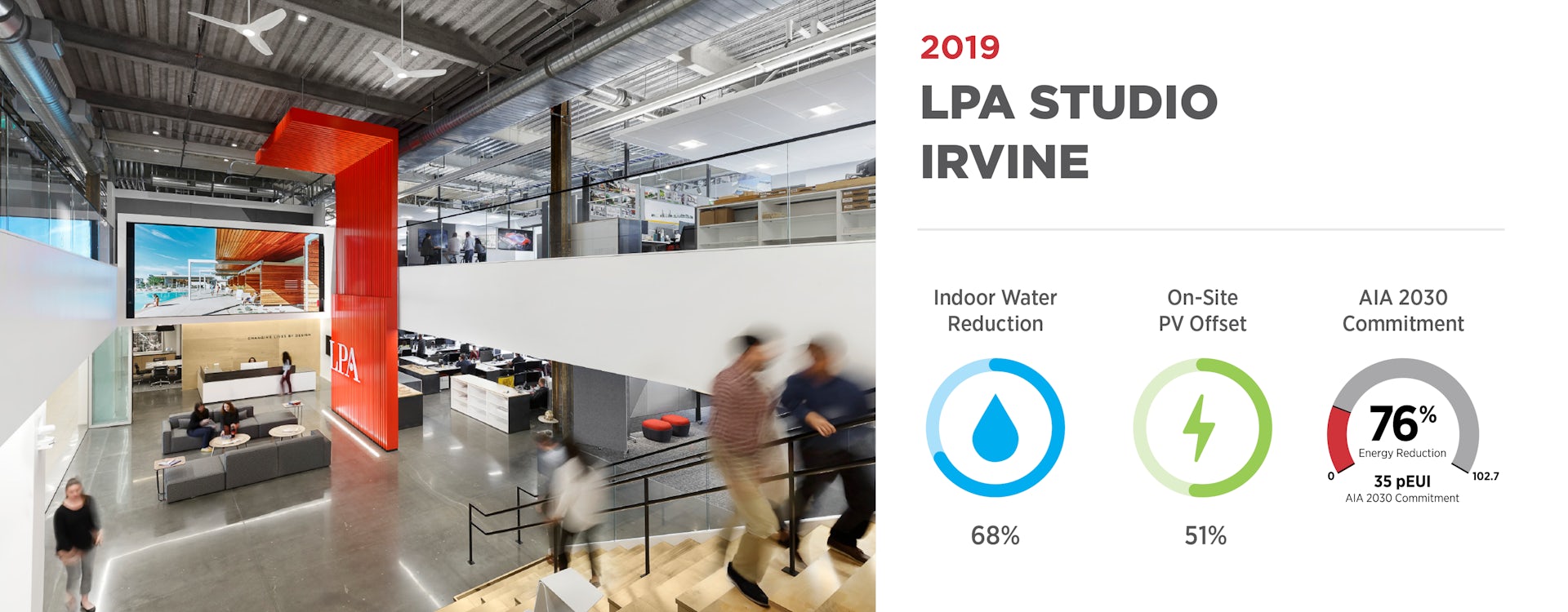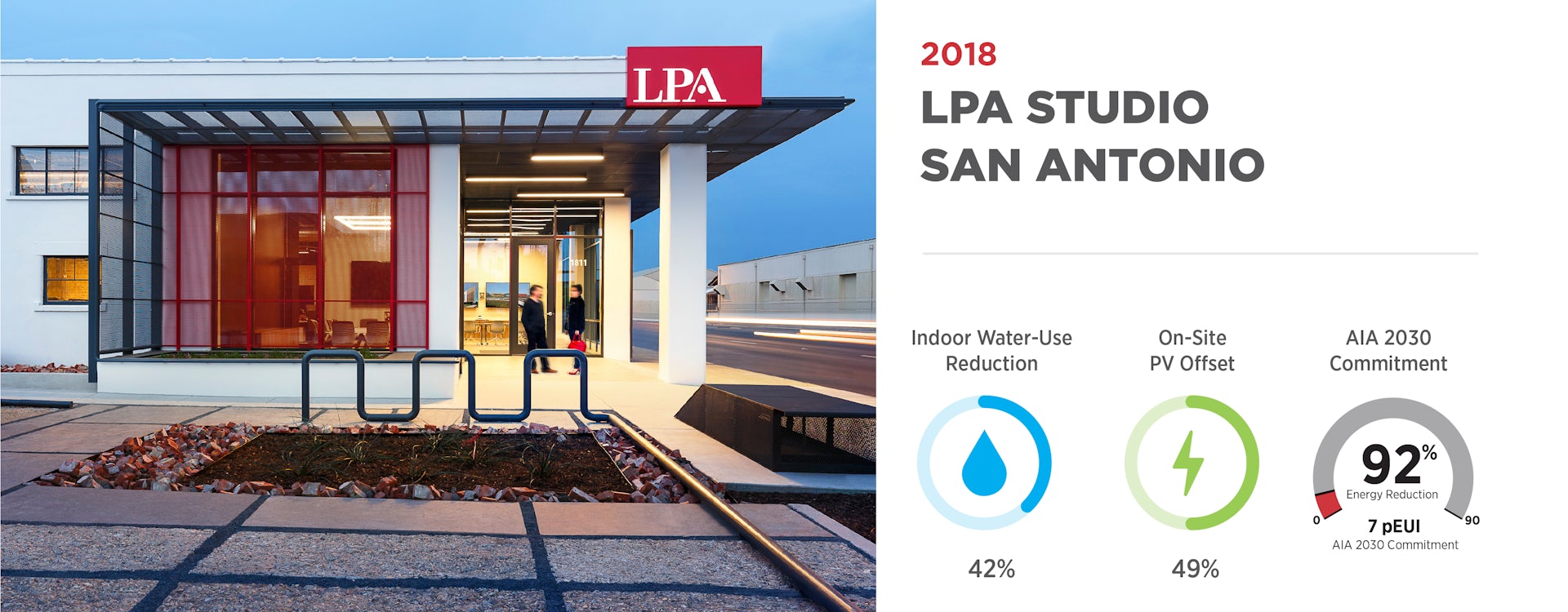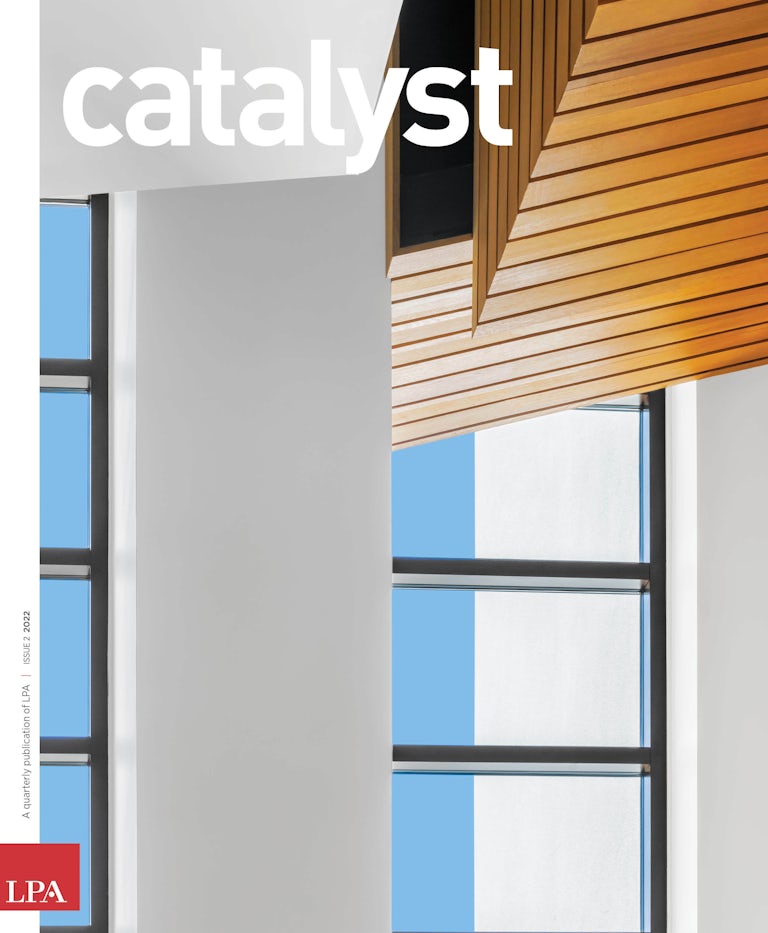Ten LPA projects have achieved LEED Platinum certification, the U.S. Green Building Council’s highest standard for sustainable design. Here’s how we did it.
The U.S. Green Building Council’s LEED certification program provides a benchmark for a building’s sustainability performance, allowing owners and designers to measure their results across a broad spectrum of energy, environmental, conservation and wellness standards.
Platinum is the highest level of achievement in LEED (Leadership in Energy and Environmental Design), surpassing Gold, Silver and Certified). The Platinum rating requires a commitment to address every element of the standard. Platinum buildings must receive a minimum of 80 points on the 110-point LEED scale for site development, water savings, energy efficiency, materials selection and indoor environmental quality. Of the approximately 75,000 commercial projects registered and certified by the USGBC, only 2,188 (fewer than 3%) have achieved Platinum status.
A single innovative idea in one area won’t be enough to make Platinum, says LPA Chief Design Officer Keith Hempel. “To reach this level of sustainability, you need to find holistic solutions,” he says. “You really have to be hitting on all cylinders and fully optimize your design solution.”
Since 2008, LPA has designed 10 buildings that have achieved LEED Platinum certification. The projects represent a wide variety of sectors, sites and topography. Each presented different challenges and opportunities. In each case LPA was able to work with the client to find design solutions that pushed the performance of the building and earned the necessary points.
For each project, the design process started with making the building as efficient as possible, maximizing passive strategies and optimizing systems, says LPA Director of Engineering Erik Ring. To earn enough points to reach Platinum, buildings typically will need to generate their own renewable energy, usually through photovoltaics (PV), to maximize the potential points in the energy category. Client participation and an integrated approach, including a wide variety of voices and expertise, are vital to hit the mark, Ring says.
“It’s essential to get all the disciplines engaged from the very beginning,” Ring says. “All parties need to be coordinated and synchronized in developing and building the design solution.”
The LPA projects, designed across a wide array of clients and project types, illustrate that Platinum can be achieved through a research-driven, integrated design process that produces innovation and better performance.
2021 | Edwards Lifesciences Entry Pavilion
The entrance to the campus expansion of a medical device manufacturer creates a new welcoming experience for visitors.
Big Ideas: The building is designed to operate at net zero energy. A large canopy shades the building glass and creates space for PV panels to offset 100% of the building’s energy use. Natural ventilation, a high-efficiency building envelope and efficient mechanical systems help minimize energy use. A system of bioretention areas and modular wetlands captures and treats stormwater.
2019 | CSU San Bernardino Center for Global Innovation
This three-story, 70,000-square-foot facility creates a new hub for the student experience on campus, with academic, social and cultural spaces.
Big Ideas: The building responds to every aspect of the site, including the hot climate, high winds and proximity to a seismic fault. Self-shading overhangs, access to natural daylight and an Energy Star cool roof help reduce energy consumption, while a 160-kilowatt photovoltaic array offsets 50% of the building’s energy use. All stormwater is collected and polished via bioswales.
2019 | LPA Irvine Studio
A typical shell office space was redesigned as a “living laboratory” of workplace and sustainable design.
Big Ideas: Under the constraints of a tenant improvement project, the integrated design found efficiencies through lighting controls and fixtures; high-volume, low-velocity fans; and water fixtures that operate 40% better than the LEED baseline. A rooftop 70-kW photovoltaic system, developed with the building owner, offsets 20% of the office’s energy use.
2018 | Environmental Nature Center Preschool
Indoor and outdoor learning environments provide children with an intuitive understanding of the natural world.
Big Ideas: Natural ventilation and building orientation dramatically reduced energy usage. The butterfly roof opens the space to natural light and is pitched to support a solar array designed to provide 105% of the preschool’s electrical needs. Indoor spaces include radiant floor heating served by heat-pump water heaters. The building does not use any mechanical cooling or fossil fuels. The roof also channels rainwater through a series of rock basins and bioswales, where the water is naturally treated and clarified by plant materials.
2018 | LPA San Antonio Studio
A long-vacant, 10,300-square-foot retail space was repurposed as a modern workplace that boosts a revitalized neighborhood.
Big Ideas: The adaptive reuse saved the existing warehouse structure. A 63.7-kW photovoltaic system, including a solar canopy over parking stalls, was installed on the leased property. Large clerestory windows were restored to fill the studio with daylight. Energy modeling helped improve the building’s performance. Stormwater runoff, including from the parking lot, is captured and treated on-site in bioretention areas.
2017 | Edwards Lifesciences Starr Atrium
A 25,000-square-foot atrium connects two office buildings and creates a dramatic new entry to the corporate headquarters.
Big ideas: The building’s use energy is 100% offset by a PV array on the roof of an adjacent parking garage. A ”truss net” structural system spans the space and maximizes natural light. A displacement ventilation system and high-efficiency lighting help minimize energy use. Sustainably sourced materials are used throughout the project; the surrounding landscaped area incorporates bioretention planter areas to clean and conserve stormwater runoff.
2015 | California State University, East Bay Warren Hall
This five-story, 67,000-square-foot facility houses offices, support spaces and the campus welcome center.
Big Ideas: The CSU system’s first LEED Platinum project features an optimized building envelope to improve thermal performance. A variable air volume (VAV) system, high-efficiency boilers and advanced lighting controls reduce energy consumption; PV offsets 24% of energy use. Half of the materials were sourced from within 500 miles. All stormwater is treated on-site.
2013 | Montgomery Middle School
A Southern California public middle school was designed to operate at net zero.
Big Ideas: Realigning the school into two rows of classrooms maximized daylight and natural ventilation. Mechanical distribution hubs at the center of each wing house the high-efficiency HVAC units, freeing roof space for PV. The light-colored angled rooftop and hardscape surfaces reduce the building’s urban-heat-island effect. A campus-wide energy management system and a thermal displacement ventilation system help to trim energy consumption.
2010 | Watson Land Company Headquarters
This two-story, 24,000-square-foot office building provides effective shading.
Big Ideas: The building envelope is designed to respond to the sun. The entry serves as a sunshade. Sustainable strategies include roof-mounted PV panels, low-flow plumbing fixtures, high-efficiency HVAC equipment, high-efficiency lighting design, an air filtration system for improved indoor air quality, materials made from recycled content and/or sourced regionally and low-emitting materials.
2008 | Environmental Nature Center
A 9,000-square-foot, net zero interpretive center focused on the natural world.
Big Ideas: The building was oriented to optimize natural light and maximize ventilation. The sloping roof faces south, allowing the PV array to take full advantage of the sun. PV panels provide 100% of the facilities’ electricity. The building’s form also optimizes natural ventilation by bringing cool air in low and releasing warmed air up high to operable windows. The project required no mechanical heating or cooling systems.
To reach this level of sustainability, you need to find holistic solutions. You really have to be hitting on all cylinders and fully optimize your design solution
- Keith Hempel, FAIA - Chief Design Officer
MOVING THE INDUSTRY FORWARD
Dan Heinfeld FAIA, LEED AP BD+C | President, LPA
The 1994 introduction of LEED forever changed the way we design and build, at a time when, frankly, we needed to change. LEED mainstreamed the idea of using performance strategies and materials to lessen a project’s ecological footprint. We have the U.S. Green Building Council’s pioneering efforts to thank for bending the curve on energy and water use, site development and healthy indoor environments.
Today, we are focusing on new standards and new goals — net zero energy, carbon positive. The bar is higher. It’s no longer simply about being less bad. The sustainability quotient of a project will be viewed much differently in the future.
But it’s important to remember that the LEED principles represented a sea change for our industry. It was a key first step. Any discussion of sustainable practices in the A & E industry needs to acknowledge LEED’s influence in moving us toward a more sustainable future.
LPA was an early adopter of LEED, joining the USGBC as a firm member in 2002. We designed the first LEED NC building in the country, the Premier Automotive Group headquarters in Irvine, and made LEED a core part of our integrated design process. We asked all our designers to be LEED certified and embraced LEED’s holistic approach as we grew as a firm. Long after we set our own internal goals for energy performance, we continued to work with our clients to meet LEED certification standards.
For us, LEED Platinum provided our teams with a clear goal, a standard that was not going to be achieved by a traditional approach. To reach Platinum, projects must be holistically designed and achieve LEED points in all seven categories of design and construction.
As we move forward, we will need to do more as an industry to have a positive effect on our communities. But LEED Platinum remains a top benchmark for our performance. You don’t get there unless you address all elements of a building’s impact. As LEED evolves, we will continue to work with our clients to find innovative ways to achieve the top standards.

























